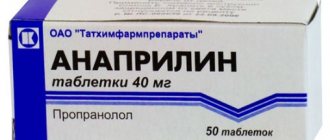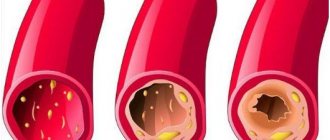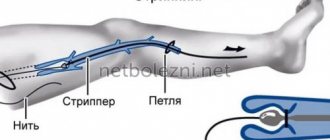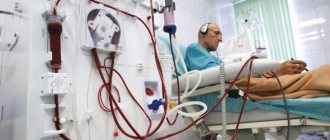Description of blood pressure medication
The medicine is widely distributed.
It was first obtained from opium, a significant amount of which is found in poppy. Hence the name of the drug - “Papaverine”. It belongs to the group of opium alkaloids, but the effect on the central nervous system is practically absent. The medication is an antispasmodic and relaxes muscle fibers. The action of "Papaverine" is aimed only at eliminating contractions of the smooth muscles of the intestines, respiratory organs and other internal organs and blood vessels. The medicine does not affect the heart and skeletal muscles. “Papaverine” does not interfere with the muscles’ response to signals from the central nervous system and has a relaxing effect. Spasm of internal organs negatively affects their functioning. But spasm of blood vessels has a more negative effect. It provokes an increase in blood pressure (BP), and blood circulation through the tissues becomes difficult. Hypoxia develops.
The product is well distributed throughout all tissues. The time required for half-life is 2 hours. It breaks down in the liver and is excreted by the kidneys during urination.
The drug Papaverine is a drug from the group of antispasmodics
Combined action of drugs
It would seem that both drugs belong to the same group and have similar effects... why not just increase the dose of one of them? But in pharmacology, not everything is so straightforward.
Drugs, interacting with each other, often cancel or distort each other’s effects; the manufacturer writes about such effects in the annotation in the “joint use” section. But it also happens the other way around, a mutual strengthening of the beneficial effects. This effect is called synergy. This property is quite rare, and sometimes it saves patients’ lives.
For example, if the bacteria that caused the disease are resistant to antibiotic A and antibiotic B, they may well succumb to a combination of these two drugs, since they mutually reinforce each other, for example, one, by breaking the cell wall of the bacteria, helps the second to penetrate the hostile microorganism and destroy his.
The combination of the effects of “Papaverine” and “Dibazol” is somewhat more complicated. They both act on smooth muscle, but in different ways:
- Bendazole removes free calcium from the muscles, which they need for contraction. If there is a lack of this element, the muscles will not be able to fully contract until the level of calcium in the muscle is restored.
- Papaverine works with other biochemical agents of muscle contraction - it reduces the activity of the enzyme inside myocytes i.e. muscle cells, which is responsible for the concentration in the cells of a substance that helps muscles contract under the influence of certain hormones, for example, adrenaline. As a result, the calcium content in myocytes again decreases.
As a result, calcium, extracted from myocytes by two different mechanisms, can no longer penetrate back into the cells, which means that the blood pressure-lowering effect of using two drugs simultaneously is not only stronger, but also longer lasting.
Neither each of the drugs individually, nor both of them lead to muscle paralysis. The muscles can contract, but much weaker. This is enough to do their job, but the spasm is stopped in this way. The drugs do not affect the muscles of the limbs - the person can move. This happens because skeletal muscles are of a different type - striated. Neither papaverine nor dibazole have any effect on it.
Papaverine instructions for use
At what pressure is the drug prescribed? With increased The course of therapy depends on the form of the medication.
Tablets are prescribed to adults three times a day, 1 piece. The maximum single dose is 200 mg. You should not take more than 600 mg of medication per day.
For children, for therapeutic purposes, a lower dosage is prescribed, which is determined depending on the age factor:
- 1) from 0.5 to 2 years – 5 mg;
- 2) from 2 to 4 years – 5–10 mg;
- 3) from 5 to 6 years – 10 mg;
- 4) from 7 to 9 years – 10–15 mg;
- 5) from 10 to 14 years – 15–20 mg.
For infants, it is better to dissolve the tablet in water. The effectiveness of the medicine does not depend on the consumption of food. It is taken for pain and spasms. If colic occurs in the gastrointestinal tract, it is better to take the tablet 30 minutes before meals. Swallow the tablet completely with a sufficient amount of water. How long the therapeutic course will last depends on the type of pathological condition. In the acute form, treatment averages 5 days, and in the chronic form – 7 days.
Papaverine tablets are intended for oral administration
When administered intramuscularly, a dosage of 20–40 mg of the drug is used 2 to 3 times a day. At a dosage of 20 mg, it is diluted in advance with 20 ml of a 0.9% aqueous solution of sodium chloride. The second injection is given no later than 4 hours after the previous one. It is not advisable for elderly patients to administer more than 10 mg of solution at a time. It is recommended to administer the medicine intramuscularly rather than intravenously, despite the fact that the latter method is more effective. But side effects with the intravenous route are more common
Injections into a vein should be done carefully; it is advisable that the procedure be performed by a qualified specialist. If possible, it is better to use tablet form and suppositories
Children receive 2 injections per day. The dosage is determined at the rate of 0.7 mg per 1 kg of weight.
The course of therapy with rectal suppositories depends on the patient’s age:
- adults – 1–2 suppositories 2 to 3 times a day;
- children under 5 years old – ¼ suppository twice a day;
- children from 5 to 10 years old - half a suppository twice a day;
- children from 10 to 18 years old - 20 mg of medication twice a day.
Suppositories are used for hemorrhoids and diseases of the genitourinary system to relieve symptoms.
How to drink Papaverine
Before using any medicine, you need to study all the nuances in more detail. "Papaverine" instructions for use:
- Use the tablets according to the following scheme: about 40 – 60 mg. several times a day (2 – 3);
- for intramuscular and intravenous administration, the dose will need to be reduced to 10 – 20 mg;
- for elderly people, no more than 10 mg;
- suppositories 20 – 40 mg. several times a day.
It is necessary to take Papaverine for blood pressure with caution. It has contraindications for children under 12 years of age, as well as a wide list of other factors:
- neurological diseases;
- low blood pressure;
- liver and kidney problems;
- foci of inflammation in the prostate gland.
Be careful, study possible side effects such as dizziness, sweating, arrhythmia, low blood pressure. Itching of the skin, constipation, vomiting or nausea may occur. Taking a large dosage may cause bradycardia.
Papaverine
This is an antispasmodic drug used to reduce the tone and contraction of smooth muscles. The drug is an opioid alkaloid produced through synthesis.
Today papaverine is available in 3 dosage forms:
- Rectal suppositories (20 mg of active substance), 5 pieces per package.
- Solution for injection - ampoules of up to 2 ml containing 20 mg of two percent papaverine hydrochloride.
- Tablets - 40 mg of active ingredient each, one package contains 10 tablets.
Papaverine has a number of different actions:
- antihypertensive;
- antispasmodic;
- sedative;
- local analgesic.
The drug inhibits the enzyme phosphodiesterase, as a result of which nucleotide (CAMP) accumulates and the calcium content decreases. This disrupts the contraction of smooth muscles, causing them to relax.
Indications for use of the product are spasms of any smooth muscles, including muscle fibers of the vascular walls. Thus, Papaverine is recommended for use in the following cases:
- elimination of smooth muscle spasm;
- functional bowel diseases;
- attacks of cholelithiasis;
- cholecystitis;
- renal colic and spasm of the urinary tract;
- bronchospasm;
- spasms of smooth muscle fibers of peripheral, coronary, and cerebral vessels, which occurs against the background of various vascular diseases (myocardial infarction, angina).
For high blood pressure, Papaverine is taken according to a specific regimen. In this case, suppositories are administered rectally, tablets are taken orally, and the injection solution is administered subcutaneously, intramuscularly or intravenously.
According to the instructions, Papaverine tablets should be taken 3-4 times a day. per day, 1-2 pieces at a time. It is recommended to administer suppositories after bowel movements, 1 suppository 2-3 r. in a day.
A single dose of solution for injection is 1 ampoule, that is, 1-2 ml. Moreover, up to 3 ampoules can be administered per day, and in the case of intravenous administration, only 1 ampoule.
Despite the fact that Papaverine quickly lowers blood pressure by relaxing the smooth muscles of the vascular walls, this drug has contraindications and side effects. Thus, it should not be used in case of hypersensitivity to papaverine hydrochloride, arterial hypotension, acute renal failure, glaucoma and in case of atrioventricular conduction impairment.
Moreover, with high blood pressure, Papaverine is not recommended for use by elderly hypertensive patients, as there is a risk of fever, and by children under 1 year of age. Also, treatment with this drug cannot be combined with taking monoamine oxidase inhibitors.
This drug has few side effects. But sometimes after taking it the following reactions occur:
- dermatological – rash, itching, hyperemia;
- nervous system – malaise, headache, drowsiness, sweating, dizziness;
- heart and blood vessels – arterial hypotension, tachycardia, heart rhythm failure;
- Gastrointestinal tract - dry mouth, diarrhea or constipation, nausea.
In rare cases, Papaverine causes hematogenous disorders, local allergic reactions, and malfunctions of the sensory organs and liver.
The price of tablets is from 16 rubles, candles – from 17 rubles. The cost of one course of injections (pack of 10 ampoules) is 45 rubles.
Contraindications
The use of papaverine and dibazole is not allowed in the following cases:
- children under 1 year of age;
- with bronchospasm;
- depression of the respiratory center;
- cerebral encephalopathy;
- epilepsy (also convulsive syndrome of other etiologies);
- hypotension;
- Impaired conduction of impulses in the heart muscle (arrhythmias and blockades);
- pregnancy and the period of feeding the baby;
- renal or liver failure.
Dibazole and papaverine are an effective remedy in the fight against high blood and intracranial pressure, especially in the early stages of the development of pathology. However, it should be remembered that self-medication with any drugs can cause a worsening of the condition if the dosage or combination of drugs is incorrectly chosen. To obtain a high and stable hypotensive effect, it is necessary to comply with the prescribed dosage of the drug.
In emergency situations, such as a hypertensive crisis, an injection of Dibazol and Papaverine is a salvation. When diagnosing hypertension, a doctor must prescribe a number of antihypertensive medications.
This combination of medications has been successfully used as an effective remedy for high blood pressure. Both drugs have similar pharmacodynamics and indications for use.
Common medications for high blood pressure are Papaverine and Dibazol
“Papaverine” has an antispasmodic effect against high blood pressure, helping to relax smooth muscles and reduce their tone. Release form of the drug:
- suppositories (used rectally);
- tablets (oral use);
- injection solution (intravenous, intramuscular or subcutaneous administration).
The function of “Dibazol” (“Bendazol”) is to have an antispasmodic and vasodilator effect. Systematic administration of the drug has a positive effect on the spinal cord and peripheral nerves.
Release form:
- tablets (taken with water);
- solution for injection (administered intramuscularly, intravenously or subcutaneously).
How to inject Papaverine with Dibazol for hypertension
The drug compound has a high antispasmodic effect. Quickly relieves vasospasm and reduces blood pressure during a crisis. It may be the only solution for a hypertensive crisis. The injection is administered gradually, without sudden infusions, subcutaneously. You can also inject intramuscularly and intravenously. The complex remedy sharply increases blood pressure, then reduces it to the normative level.
The ratio is determined by the doctor. For adults, two to three injections per day are recommended, a single dose of no more than 5 ml. For children, depending on their age category, a single dose is prescribed up to 2.5 ml. The combination of Dibazol and Papaverine solution for high blood pressure in the form of injections is prescribed for a course of 10 to 14 days. During this period, it is possible to achieve restoration of blood pressure levels.
It is important to remember: self-medication is dangerous to health; at the first signs of illness, consult a doctor. . Arterial hypertension is a disease that often becomes a problem not only for the elderly, but also for young people
Which form of the drug to choose
First of all, you need to know that medicines have three forms: tablets, suppositories, ampoules. Undoubtedly, the most convenient for use are suppositories that have a quick effect without the need for injections. The positive side of taking pills is that the drug quickly enters the bloodstream, thereby having a positive effect. The tablets also have an effect on blood vessels. It is the doctor who prescribes a course of rehabilitation based on combining drugs in the right quantity. When giving injections, the drug is administered gradually, and constant measurement of blood pressure is necessary. The dosage in all forms is the same for various diseases and conditions, and differs only depending on the age of the person using the drug.
For any diseases where Papaverine is required, you can choose the form that will be most convenient. For example, if it is best for a patient to take pills, then this form should be chosen. If you need to quickly achieve the appropriate effect, especially in the first days of exacerbation of the disease, then you should pay attention to injections.
Effective mixture
If you are an experienced hypertensive patient, you have probably used emergency medical services. In case of a hypertensive crisis, an experienced doctor will suggest that you take a blood pressure injection with Papaverine and Dibazol, the dosage of which depends on the severity of the condition.
Let's figure out why this particular combination of drugs has earned great popularity among doctors and patients. For what reasons does this particular regimen remain effective, despite the emergence of many new modern drugs?
Dibazol - belongs to the group of antispasmodics, blocks the direct flow of calcium into the muscle cells of blood vessels, and prevents tonic tension of arterioles.
Drug Dibazol
It has a lytic effect on the sympathetic nervous system; its neurotrophic and neuroprotective effects have been proven. Has good immunostimulating properties. It is available on the market in two forms - a 1% solution in ampoules of 5 milliliters and tablets of 20 mg.
Papaverine is a myotropic antispasmodic, like Dibazol, and has a relaxing effect on the vascular wall. Widely used for diseases based on smooth muscle spasm. Such diseases include cholecystitis, biliary and renal colic.
A curious fact is that Papaverine is synthesized from jelly of the poppy, like Morphine, but it does not have a narcotic effect and is not addictive. Available in the form of a 2% solution for injection, in ampoules of 10 pieces per package. Available without a prescription. Has a slight sedative effect.
The drug Papaverine
Both drugs have a high safety profile, low cost, proven effectiveness and are available in pharmacies without a prescription, potentiating (increasing the effect) of each other, working on different links of the same chain. The effect of the medications is immediate; after 30 minutes, blood pressure begins to drop.
Injections of Dibazol with Papaverine for blood pressure, the dosage of which depends on the severity of the manifestations of hypertension, reduce total peripheral resistance, the vessel wall relaxes, the load on the heart decreases, which begins to work with less effort, and metabolic processes in cardiomyocytes improve.
Despite their high safety, you should consult your physician before taking medications.
Injections for blood pressure Papaverine with Dibazol proportions, dosage and nuances of use
The use of papaverine and dibazole is not allowed in the following cases:
- children under 1 year of age;
- with bronchospasm;
- depression of the respiratory center;
- cerebral encephalopathy;
- epilepsy (also convulsive syndrome of other etiologies);
- hypotension;
- Impaired conduction of impulses in the heart muscle (arrhythmias and blockades);
- pregnancy and the period of feeding the baby;
- renal or liver failure.
Dibazole and papaverine are an effective remedy in the fight against high blood and intracranial pressure, especially in the early stages of the development of pathology.
However, it should be remembered that self-medication with any drugs can cause a worsening of the condition if the dosage or combination of drugs is incorrectly chosen.
To obtain a high and stable hypotensive effect, it is necessary to comply with the prescribed dosage of the drug.
In emergency situations, such as a hypertensive crisis, an injection of Dibazol and Papaverine is a salvation. When diagnosing hypertension, a doctor must prescribe a number of antihypertensive medications.
This combination of medications has been successfully used as an effective remedy for high blood pressure. Both drugs have similar pharmacodynamics and indications for use.
Common medications for high blood pressure are Papaverine and Dibazol
“Papaverine” has an antispasmodic effect against high blood pressure, helping to relax smooth muscles and reduce their tone. Release form of the drug:
- suppositories (used rectally);
- tablets (oral use);
- injection solution (intravenous, intramuscular or subcutaneous administration).
The function of “Dibazol” (“Bendazol”) is to have an antispasmodic and vasodilator effect. Systematic administration of the drug has a positive effect on the spinal cord and peripheral nerves.
Release form:
- tablets (taken with water);
- solution for injection (administered intramuscularly, intravenously or subcutaneously).
How does the medicine work?
Both Dibazol and Papaverine are effective treatments for high blood pressure. The drugs have similar therapeutic properties; taken together, their effect on the body is more effective.
They reduce painful spasms, promote dilation and relaxation of blood vessels and muscles. Injection administration accelerates the process of active substances entering the blood.
As a result, blood pressure decreases faster, and the process of crisis development is reversed.
Both products are commercially available. They are also both present in "Papazole". However, as already mentioned, you should not self-medicate; the dosage of Dibazol injections with Papaverine for blood pressure is determined by the doctor in each individual case.
Properties and effects of drugs
The indications for use of these two drugs are almost the same.
They have a vasodilating effect, eliminate spasms and relax the smooth muscle muscles of internal organs and blood vessels.
However, the best effect is achieved by the combined use of Papaverine and Dibazol in one syringe when administered intramuscularly. First, we will talk about the properties of each drug separately.
Dibazol
Crystalline powder with a yellowish or gray tint. Available in the form of tablets, powder or solution for intravenous administration. The solution is sold in ampoules of one, two or five milliliters, packed in cardboard boxes. One package contains ten ampoules.
Solution for injection Dibazol
Dibazol is characterized by the following properties:
- relaxes muscle tissue;
- eliminates muscle spasms, muscle spasms of the blood vessels of the circulatory system and internal organs;
- dilates peripheral vessels, which leads to improved blood circulation and reduced stress on the heart;
- produces a moderate hypotonic effect;
- has an immunomodulatory effect (increases the body’s immunity), enhances the production of interferon;
- stimulates interneuronal transmission in the spinal cord, which makes it possible to use Dibazol in the treatment of neurological diseases.
One of the advantages of Dibazol, in addition to effective and rapid reduction in blood pressure, is its good tolerance by the body.
Papaverine
It is a white crystalline powder, practically odorless and bitter in taste. Available in tablets of 0.01 and 0.04 grams, in ampoules as a solution for injection of 2 milliliters. The cardboard package contains ten ampoules.
Solution for injection Papaverine
Papaverine has the following properties:
- moderately reduces blood pressure;
- relieves spasm of smooth muscles of the gastrointestinal tract;
- eliminates kidney spasms;
- eliminates bronchospasms;
- used for spasms of smooth muscles, peripheral, cerebral and coronary vessels that occur against the background of inflammatory processes and other vascular diseases;
- inhibits the production of phosphodiesterase, thereby lowering calcium levels
It has the property of rapid absorption by the body with any method of use.
Recommendations for treatment
In our article, we examined issues related to the properties and combined action of Dibazol and Papaverine, described how to inject these drugs correctly at home, reviewed the indications for use, and also described contraindications.
Finally, it remains to list some recommendations that must be followed during treatment:
- reduce the number of cigarettes you smoke, or better yet, give up this bad habit altogether;
- regularly monitor blood pressure and body temperature;
- reduce alcohol consumption;
- do not take drugs that have a vasoconstrictor effect;
- If possible, it is necessary to avoid stressful situations;
- follow the diet recommended by your doctor;
- Visit your doctor regularly and follow all his recommendations.
Indications for the use of Indapafon tablets are chronic high blood pressure and a period of hypertensive crisis. Its antihypertensive effect does not appear immediately, but gradually.
Thromboass is used in the treatment of cardiovascular diseases, as well as for their prevention. At the same time, it shows good efficiency.
Dibazol injections with Papaverine dosage for blood pressure
If you purchased the drugs separately, the drugs are mixed in a syringe before administration. The exact dosage is prescribed by a doctor, who is guided by the clinical characteristics of the manifestation. For high blood pressure, the most common dosage is 4 ml of Dibazol and 2 ml of Papaverine. If elevated blood pressure is observed against the background of hypertension, then additional analgesics are taken with the injection.
When you need to inject Papaverine with Dibazol and how, it will become clear from the instructions. Carefully read the contents of the information inserts for the drugs. Follow your doctor's orders
Pay attention to the sections on contraindications and side effects
With any treatment, it is important not only to eliminate the symptoms, but also not to harm the body as a whole.
Instructions for use
The norm of blood pressure is individual for each person. It varies depending on the age of the patient
It is extremely important to take this factor into account during diagnosis and treatment. Sudden vasospasm can provoke the occurrence of persistent arterial hypertension
Signs of a crisis that require the prescription of medications:
- nose bleed;
- nausea;
- severe headaches;
- pain in the heart area;
- loss of orientation in space;
- loss of consciousness;
- blurred vision, dark spots before the eyes;
Indications for use of the product: spasm of any smooth muscles, including muscle fibers of the vascular walls
- speech disorder;
- loss of mobility and sensitivity of the limbs;
- nausea, vomiting;
- convulsions;
- severe shortness of breath;
- excessive excitability.
Indications and instructions for use
The use of Dibazol with Papaverine in one syringe is recommended for the following diseases, but in strict accordance with medical prescriptions:
- endarteritis;
- pain in the heart area;
- with convulsions;
- bronchospasm;
- angina pectoris;
- duodenal ulcer;
- facial paralysis;
- hepatic colic;
- renal colic;
- with weakened immunity;
- at the initial stage of arterial hypertension;
- diseases of internal organs, which are accompanied by contraction of smooth muscles;
- spasms of cerebral vessels, as well as intestinal spasms;
- when flu symptoms occur.
When administering Papaverine with Dibazole, the instructions for use indicate the need for their joint use when obvious signs of a hypertensive crisis appear.
Source: //medic-help.ru/sosudy/dibazol-s-papaverinom-ot-davlenia-dozirovka/
Dibazol and Papaverine combination for hypertensive crisis
http-equiv=”Content-Type” content=”text/html;″>href=”https://gipertonija.ru/wp-content/uploads/2016/11/1-216.jpg” data-slb-active =»1″ data-slb-asset=»243602590″ data-slb-internal=»0″ data-slb-group=»14699″>
Very often, for high blood pressure, two medications are used at once - Papaverine and Dibazol. This combination significantly reduces antispasmodic pain, dilates blood vessels and alleviates severe hypertension.
These drugs enhance the effectiveness of each other, so they are used in combination. The drugs are administered intramuscularly, which quickly reduces blood pressure and helps prevent the occurrence of a hypertensive crisis.
The advantage of taking Papaverine and Dibazol together is that there are practically no adverse reactions, but increased medicinal activity occurs. But the amount of dose and course of treatment with drugs should only be prescribed by a doctor, taking into account the individual characteristics of the patient’s body.
As a rule, an injection containing 4 ml of Dibazol and 2 ml of Papaverine effectively lowers blood pressure. But this dosage is approximate
In order for the combination to be optimal, it is important to take into account not only blood pressure indicators, but also the difference between upper and lower pressure.
It is not uncommon, if the patient’s condition is critical, Papaverine and Dibazol are combined with Analgin, which will enhance the analgesic effect.
It is worth noting that Papaverine and Dibazol are already available in a combined dosage form, which doubles the antihypertensive effect. But sometimes such complex treatment causes some adverse reactions:
- low myocardial contractility;
- nausea;
- dizziness;
- hyperhidrosis;
- allergic reactions.
In conclusion, we offer a video in this article, which raises the issue of using papaverine for hypertension.
Enter your pressure
130 to 90
Search in progress Not found
Latest discussions:
Properties of drugs
Dibazole and Papaverine are most often used for high blood pressure.
It is a white crystalline powder of a grayish or yellowish tint. It is slightly soluble in water, but easily soluble in ethyl alcohol.
- Dilates the peripheral blood vessels of the body.
- Reduces spasms.
- Has a relaxing effect on the muscle structure.
- Has a moderate hypotonic effect.
- Dibazol significantly reduces the tone of blood vessels . which entails a moderate but prolonged decrease in blood pressure. Increases blood supply to the ischemic part of the myocardium. Accelerates the transmission of nerve impulses in the spinal cord, which makes the drug popular for the treatment of various neuralgic diseases.
- Another important feature of dibazole is the increase in the body’s immunity due to increased production of endogenous interferons.
- The use of dibazole prevents total peripheral vascular resistance (TPVR), caused by non-selective (non-selective) adrenergic blockers. Enhances the effect of diuretic and antihypertensive drugs. Phentolamine provokes an increase in the hypotensive effect of bendazole.
- When using high doses of dibazole , increased body temperature, sweating, dizziness and nausea are possible. The drug should not be prescribed in large dosages and for a long time to elderly people.
In its pure form it is a white crystalline powder. It has a bitter taste and a weak specific odor. It is poorly soluble in water and slightly soluble in ethyl alcohol. It is highly soluble in chloroform and slightly soluble in ether.
- Slows down the production of phosphodiesterase.
- Reduces the level of calcium ions.
- Reduces the tone and relaxes the smooth muscles of some internal organs of the gastrointestinal tract and genitourinary system.
- In increased dosage, it reduces the excitability of the ischemic region of the heart.
- Has a moderate reduction in blood pressure.
- The main pharmacological effect of papaverine is an antispasmodic and hypotensive effect. Slows down the production of phosphodiesterase and causes the cell to produce cyclic 3′.5′ adenazine monophosphate, thereby lowering calcium levels.
- It is quickly and almost completely absorbed by the body using any method of administration. In blood plasma it binds to proteins. Normally passes through histomatic barriers. Biotransformation of papaverine occurs in the liver.
- The half-life of the drug from the body: from half an hour to two hours, depending on the functioning of the digestive organs and hematopoiesis. In older people, the half-life of the drug from the body may increase. This should be taken into account when determining the frequency and dosage of the drug.
Indications
The combination of dibazole and papaverine is used for labile arterial hypertension, that is, periodic rises in blood pressure to a high level. In addition, the list of indications includes spasm of peripheral vessels, including the brain, and smooth muscles of internal organs. For permanent therapy, combination drugs, for example, Papazol, are used in neurology.
Usually a combination of antispasmodics is prescribed by a doctor, who also selects the dose . In the case of a hypertensive crisis, the dose is determined by the emergency medical team. But there are situations when the ambulance does not have time, for example, if the patient is at the dacha or in other places remote from civilization.
It is acceptable to help a sick person using these remedies, but it is better to call an ambulance and consult a doctor. Now in the “03” service, in addition to the dispatchers who receive the call, there are medical practitioners who clearly explain to the caller what can and cannot be done before the team arrives.
A hypertensive crisis is a significantly increased blood pressure value, up to 180/110 and above, that occurs suddenly - an extremely dangerous condition, which can result in a heart attack, stroke, or pulmonary edema. During an attack, the patient experiences anxiety, severe headaches and chest pain.
Usually, hypertensive patients always have prescribed medications on hand, which always help them.
But you may forget to take your medications with you or you may run out of them. A hypertensive crisis may also occur for the first time. This means that, most likely, the patient developed hypertension a long time ago, and he simply did not pay attention to its symptoms. Primary hypertensive crisis requires mandatory hospitalization .
This life-threatening condition simply needs to be brought under control. The symptoms of a hypertensive crisis are especially dangerous in pregnant women. This may indicate preeclampsia, a life-threatening condition for both the mother and the unborn child. In this case, emergency hospitalization is required in a specialized hospital - a gynecological department or a maternity hospital.
The combined effect of Dibazol with Papaverine on blood pressure
These drugs enhance the effectiveness of each other.
"Dibazol" and "Papaverine" have similar pharmacological properties. Together they are a very powerful remedy for high blood pressure. Their combined use has a faster effect on the body. An intramuscular injection of this “cocktail” quickly lowers blood pressure and helps prevent the development of a hypertensive crisis and relieves pain. Thus, symptoms of a hypertensive crisis (high blood pressure, chest pain, dizziness, loss of consciousness, nausea, vomiting) are a direct indication for the use of these two drugs together.
Return to contents
Contraindications for use
However, despite the fact that these drugs have virtually no side effects, their prescription and use should be approached very carefully. The doctor must take into account blood pressure indicators, the difference between systolic and diastolic pressure, the general condition of the patient, his age
After all, there are many contraindications for these medications:
- hypersensitivity to the components of the drugs;
- low diastolic pressure;
- kidney and liver diseases;
- elderly age;
- increased intraocular pressure;
- impaired glucose absorption;
- stomach ulcer, which is accompanied by bleeding;
- postpartum period.
Return to contents
Dosage and how to take it?
The drug contains the active ingredients of both Dibazol and Papaverine.
In addition to the fact that “Papaverine” with “Dibazol” can be used for high blood pressure by mixing solutions of these drugs in a syringe, there is also a product that already contains the active ingredients of both “Dibazol” and “Papaverine” - this is. This drug also reduces high blood pressure, which is caused by spasms of blood vessels in the brain. It contains 30 mg of “Dibazol” (bendazole) and 30 mg of “Papaverine” (papaverine hydrochloride). They must be taken according to the instructions or doctor’s prescriptions, but no more than 3 tablets per day for an adult.
As for injections, with high blood pressure they can be injected both intravenously and intramuscularly. It should be noted that these injections are an emergency treatment for high blood pressure. The most common dosage is 4 ml of Dibazol and 2 ml of Papaverine. Although other proportions are also used. For example, from 6 to 8 “cubes” of “Dibazol” and from 4 to 6 “cubes” of “Papaverine”. If, when administering the mixture, severe pain is observed or the person is in critical condition, then “Analgin” is additionally used. When the drugs are administered together with Analgin, the patient avoids sharp and stabbing pain in the temple area.
The injection takes effect after 20-30 minutes. After the injection, the patient needs to rest. You should refrain from driving a car or other complex machines and mechanisms, since the mixture not only lowers blood pressure and restores the normal state of the body, but can also cause lethargy and drowsiness. And finally, remember that our lives are subject to stress. And almost every one of them increases blood pressure and destabilizes your health. The main task is to select, with the help of a doctor, an effective drug that lowers blood pressure, and take it according to the recommendations of a specialist!
Enter your pressure
Move the sliders
120 by 80
Dibazol with Papaverine for blood pressure - dosage and instructions for use, how to inject in one syringe
In an emergency with high blood pressure, only an injection can save your life.
Timely injections and properly selected medications can prevent hypertension. The Papaverine and Dibazol complex in one syringe effectively combats exacerbation of hypertension, reducing pain. Indications for the use of medications are almost similar. Both drugs act as vasodilators, as antispasmodics, having the properties of relaxing the smooth muscle muscles of blood vessels and internal organs. Data:
- Papaverine and Dibazol dilate blood vessels due to pressure, allowing you to quickly stop a hypertensive crisis and achieve a decrease in blood pressure.
- The drugs are prescribed in a complex manner to enhance the therapeutic result.
- The combination of such powerful antispasmodics alleviates the course of hypertension and shows results with almost no side effects.
An intramuscular injection of Dibazol with Papaverine is effective for high blood pressure caused by a sharp spasm of blood vessels. In case of critical condition of the patient, acute temporal pain of a stabbing nature, it is better to add Analgin to the combination of drugs to enhance pain relief. It is necessary to follow the instructions on how to inject Papaverine with Dibazol yourself:
- You should take a lying position, but you can give the injection while standing.
- For an intramuscular injection, a syringe with a needle up to 80 mm is suitable.
- It should be administered smoothly, without haste, making sure to monitor blood pressure levels.
- A common area for injection is the gluteal or thigh muscles. If the injection is placed in the thigh, you should lie on your back.
- The point of the new injection should be at least one centimeter from the previous injections.
Proportions of Dibazol and Papaverine
The proportions of Papaverine and Dibazole are mixed in a syringe in a ratio of 2 and 4 ml of each product, but this composition of the solution is conditional.
For the purpose of optimal action of the complex, in addition to the blood pressure level, the difference in pressure indicators of the upper and lower should be taken into account. It is very important that the proportions of medications are prescribed by a qualified doctor.
The drugs are also available in combined pharmaceutical form, but this injection format may increase the risk of adverse reactions.
Dibazole with Papaverine for blood pressure - the dosage of intramuscular injections is prescribed by a doctor, who determines the dose taking into account the development of the disease and contraindications of drugs. If the dosage of Papaverine and Dibazol is exceeded, due to a sharp decrease in blood pressure, the following may begin:
- dizziness, pain;
- nausea, double vision;
- hyperhidrosis, weakness;
- allergic reactions;
- decreased myocardial contractility.
According to the instructions, injections are contraindicated for use:
- diabetics;
- hypotensive patients;
- with gastrointestinal bleeding;
- glaucoma;
- renal failure.
Other nuances:
- The composition is not recommended for treatment in old age after 60 years.
- Parenteral administration of drugs is not intended for a long course of use; they are used for one-time relief of spasms and for quick emergency therapy.
- Next, the doctor prescribes other forms and drugs used according to medical instructions, such as Papazole, or drugs with a similar effect in tablets.
: how to reduce blood pressure
Source: https://sovets.net/10374-dibazol-s-papaverinom-ot-davleniya-dozirovka.html
Description and features of the medication
Papaverine or Papaverinum (Latin name), although it is produced from poppy straw, is not classified as a narcotic drug. According to the chemical formula, it is an alkaloid, which was developed in 1848 by the German chemist G. Merck. Refers to vasodilators and myotropic antispasmodics.
Papaverine is used for various diseases and in completely different areas of medicine. Produced in 3 forms:
- ampoules;
- pills;
- candles.
The form of taking medication for high or low blood pressure, as well as for other ailments, can only be prescribed by a doctor, and only a specialist can determine the exact dosage. Before taking, you need to read the instructions and follow them exactly, so as not to harm the body with an overdose and side effects.
The main task of the medication is to eliminate acute signs of the disease, and not to treat it, so Papaverine for pressure can be used once, and not systematically. The entire course of treatment must be prescribed by a doctor and supervised by him.
Papaverine suppositories for blood pressure
Main benefits of Papaverinum:
- multifunctional, acts on several symptoms at once;
- well accepted by most patients;
- suitable for all age categories;
- affordable.
How to use
The dosage of the drug depends on the form of release, the severity of clinical symptoms and the age of the patient. Before use, you should consult your doctor, as increasing the dosage on your own may cause negative consequences for the body. However, its reduction will lead to a lack of therapeutic effect.
Papaverine tablets can be taken regardless of meals, swallowed whole (do not bite or chew) and washed down with a sufficient amount of liquid. According to the instructions for use, the following dosages are recommended for patients of different ages:
- adults and children over 15 years old – 1-1.5 tablets;
- 10-14 years old – 1.5-2 children;
- 7 years – 1-1.5;
- 5-6 years – 1;
- 2-4 years – 0.5-1;
- infants 6-12 months - 0.5 children's tablet.
The frequency of administration at any age is 3-4 times a day, and the duration depends on the severity of symptoms. For acute conditions, the drug can be taken for 2-5 days, for chronic diseases – 1-3 weeks.
Advice: for spasms of the gastrointestinal tract, it is recommended to take Papaverine 10-30 minutes before meals, so that it has time to have a therapeutic effect and the patient can eat normally.
Injection ampoules contain a 2% solution, ready for administration. Adults can inject it 2-4 times a day, children - twice a day, the dosage is determined depending on the age of the patient:
- 6-12 months – 0.25 ml;
- 2-4 years – 0.25-0.5 ml;
- 5-6 years – 0.5 ml;
- 7 years – 0.5-0.75 ml;
- 10-14 years – 0.75-1 ml;
- 15 years or more – 1-2 ml.
It is best to inject Papaverine solution into the lateral thigh or upper arm, and the syringe should be inserted deep enough so that the needle is at an angle of 90 degrees.
Attention: when re-injecting the solution, you should choose a point that is at least 1 cm from the site of the previous injection. . Suppositories (candles) are inserted into the anus with clean hands or wearing sterile gloves.
The approximate dosage for adults is 1-2 suppositories 2-3 times a day, for children over 10 years old - 1 suppository twice a day. For a child under this age, the suppository should be cut into pieces - up to 4 years, the dosage is ¼ or ½ suppository, from 5 to 10 - ½ suppository twice a day.
Suppositories (candles) are inserted into the anus with clean hands or wearing sterile gloves. The approximate dosage for adults is 1-2 suppositories 2-3 times a day, for children over 10 years old - 1 suppository twice a day. For a child under this age, the suppository should be cut into pieces - up to 4 years, the dosage is ¼ or ½ suppository, from 5 to 10 - ½ suppository twice a day.
How is the injection given?
The speed of its action depends on how correctly the drug is administered during injection. Also, a correctly placed injection minimizes the risk of negative consequences for the patient. If, against the background of a sharp vascular spasm and a surge in pressure in the temples, an acute stabbing pain is noted, analgin is added to the “cocktail” in a dosage of 2 ml.
It is strictly prohibited to prescribe injections of Dibazol with Papaverine on your own. In case of particularly severe hypertension, when the patient often develops a condition that threatens a crisis, the dosage of the injection composition can be selected by a doctor for home use, but only in extreme cases. The “cocktail” is not used for prevention.
Position of the patient and injection site
It is optimal to give the injection when the patient is in a lying position. However, if necessary, the drug can be administered to a standing patient. It is highly not recommended to inject while sitting, since due to somewhat impaired blood circulation, the speed of action of the drug will be reduced.
For intramuscular administration of the composition, a syringe with a needle length of 80 mm is used. The medicine is administered slowly, even in severe cases. It is important to constantly monitor the patient's blood pressure level.
If the drug is administered intravenously, then the bend of the elbow is selected. For intramuscular injections, the drug is injected into the thigh or gluteal muscles. In the first case, the patient is in a supine position, and in the second, on his side.
When a second injection is required, the site for it is selected at least 1 cm from the previous one. For intravenous administration, if a catheter is installed, then all drugs are administered through it.
After injection
A sharp decrease in pressure is a shock for the body, and therefore, after administration of the drug, even when the pressure is normalized, exercise is contraindicated for another 2-3 hours. It’s good if you can sleep during this period. During this time, high blood pressure finally normalizes.
Indications for use
Both Papaverine and Dibazol have almost the same indications for use and these drugs are prescribed in similar conditions to carry out a vasodilator effect and relax the smooth muscles of blood vessels and internal organs.
These two drugs have mutually reinforcing properties and are used in complex therapy to multiply the positive therapeutic effect. This complex - Papaverine with Dibazol - is a very powerful remedy for high blood pressure, and intramuscular injections of the complex of these two drugs make it possible to quite quickly reduce blood pressure and prevent the development of a hypertensive crisis. These drugs are included in the drug Papazol. Two vasodilator antispasmodics, acting together, show virtually no side effects and exhibit high medicinal activity.
However, the use itself and the proportions and doses of Papaverine with Dibazole should be prescribed exclusively by a doctor, taking into account the individual characteristics of the patient and based on the therapeutic purpose.
In what proportions should Papaverine and Dibazol be used?
In order to most effectively reduce blood pressure, before injection, you should combine two milliliters of Papaverine and four milliliters of Dibazole in one syringe. However, this is an approximate proportion, and it is very important that a qualified specialist determines both the ratio and dosage. It is necessary that in case of hypertension, not only the value of high blood pressure is taken into account, but also the difference between the upper and lower values. In case of increased pain, Analgin is additionally prescribed to the complex of Dibazol with Papaverine to enhance the analgesic effect.
Release form
Dibazole with Papaverine is also available in a combined dosage form. This is a combined vasodilator and antispasmodic drug Papazol. Its effect is almost the same as when using these two drugs separately. The direction of action of such a medicinal formula is to accelerate and enhance the therapeutic effect.
Side effects
Infrequent side effects such as nausea, allergic reactions, increased sweating, dizziness and decreased myocardial contractility are also possible.
MOST INTERESTING NEWS
Some of the widely used drugs in the fight against high blood pressure are Dibazol and Papaverine. They are part of the group of myotropic antispasmodics. The action of this group of drugs is aimed at relaxing muscles, relieving spasms and, as a result, relieving pain. To reduce blood pressure and obtain a stronger effect, Dibazol and Papaverine have been used together for a long time. They can be purchased in pharmacies without a prescription, but complex use is possible only with a doctor’s prescription. In order to understand? How do these two drugs act on the human body in combination? Let’s first look at each of them separately.
Medical reviews
Reviews from doctors about the drug composition are somewhat different.
- The use of an injection composition of Dibazol and Papaverine is best used only in emergency cases. If a smooth reduction in blood pressure is possible with the help of milder drugs, then preference should be given to them.
- Due to the presence of a significant list of contraindications, tablets to lower blood pressure are prescribed to patients only if other means do not give the desired result. Overdoses of the composition are particularly dangerous due to the risk of a sudden extreme decrease in blood pressure.
- Both drugs belong to the group of outdated drugs for the treatment of hypertension. Modern drugs allow therapy to be carried out more gently and with less likelihood of negative side effects and overdose. This is especially true for injection formulations.
- The risk of an allergic reaction is quite high, especially now that a large percentage of the population suffers from allergies. Because of this, after using medications to lower blood pressure, the patient's condition should be monitored.
- The composition with Dibazol and Papaverine gives quick results in the development of a hypertensive crisis and prevents its consequences. In the form of injections, the drug is effective in providing first aid, even in borderline patient conditions.
What injections are needed for high blood pressure? Deleted video Drugs to lower blood pressure
Analogues of the drug
The most well-known muscle relaxants, antispasmodics and antihypertensive drugs, with an effect similar to papaverine, are Andipal, Belalgin (active substance metamizole sodium), No-shpa (drotaverine hydrochloride), similar in composition to Spazmalgon and Renalgan.
The combined drugs Andipal and Belalgin contain a non-steroidal anti-inflammatory substance, have a pronounced analgesic, vasodilator, antispasmodic effect, and have a weak antipyretic and antihypertensive effect.
No-spa is an antispasmodic drug that has a myotropic effect on the smooth muscle tissue of the walls of blood vessels and hollow organs, promoting a moderate expansion of the lumen of blood vessels without affecting the nervous system.
Spazmalgon and Renalgan include 3 components: metamizole sodium, fenpiverinium bromide, pitofenone. These medications relieve inflammation and pain, eliminate muscle spasms, lower body temperature, and block the neurotransmitter acetylcholine.
Papaverine hydrochloride is completely absorbed in the intestine and acts very quickly. Its dosage forms are available from pharmacies only with a prescription. Therefore, before using the drug for blood pressure, you should consult your doctor and carefully read the instructions.










